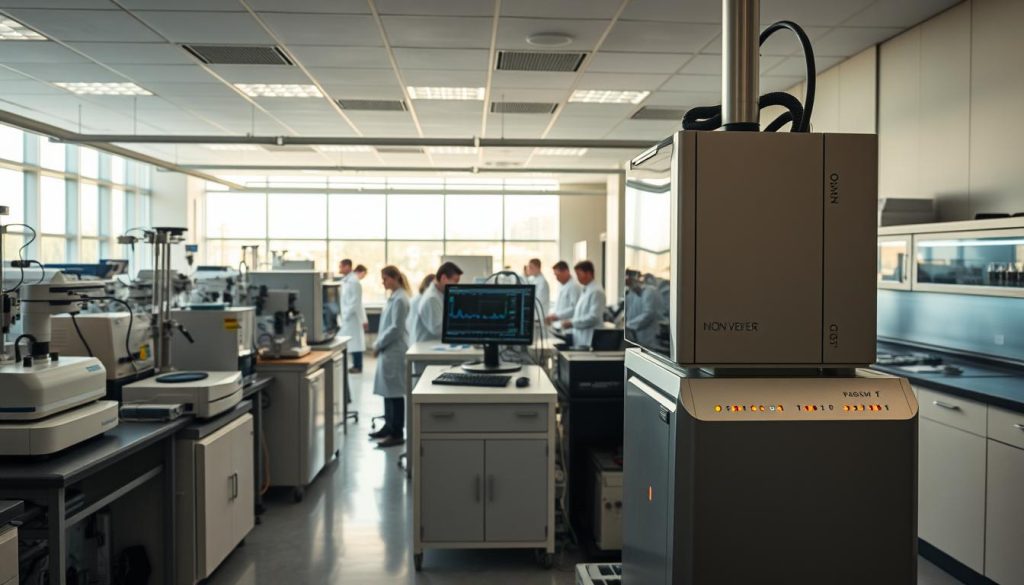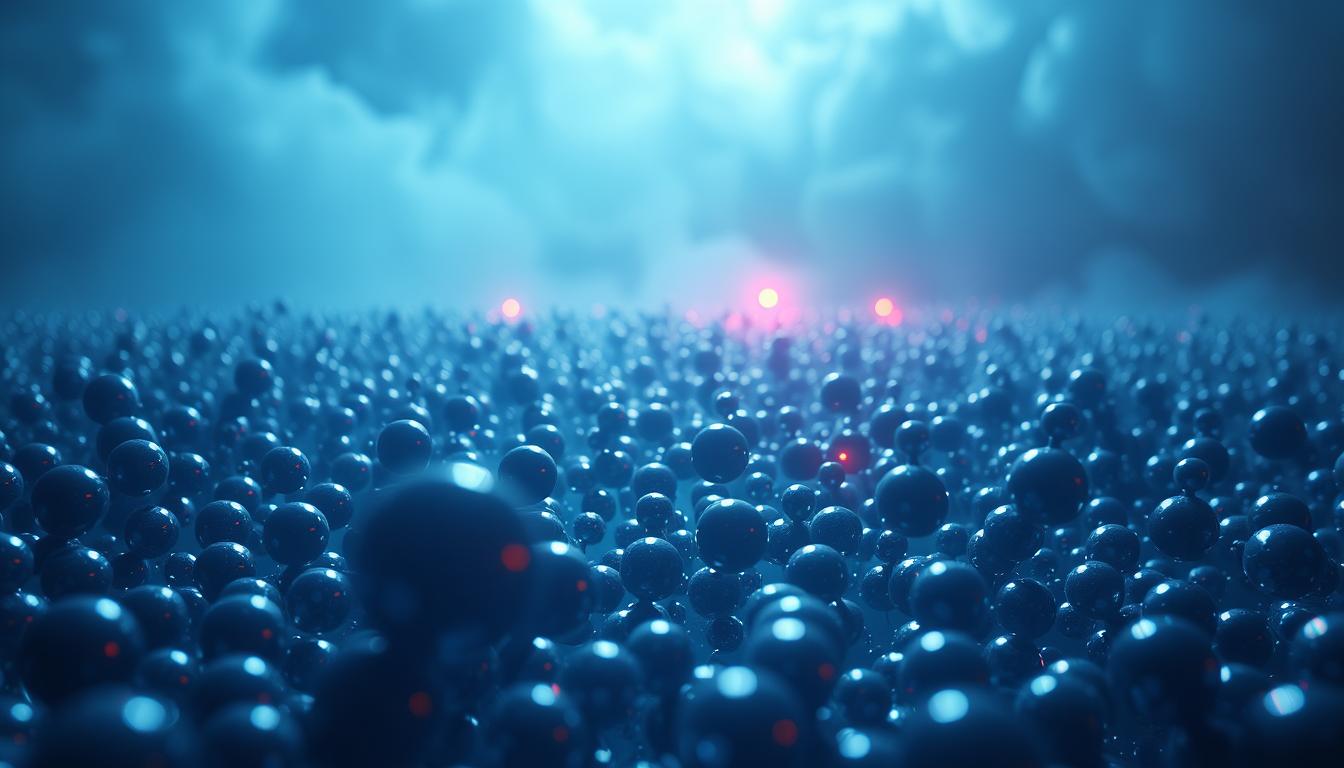Welcome to a journey into the world of ion science. This introduction will help you understand the big difference between negative and positive ions. You’ll see how they affect our health and the environment.
If you’re interested in better air quality or want to know about ion health impacts, we’ve got you covered. We’ll compare negative and positive ions to make these tiny particles clearer. This will help you understand their big role in our well-being.
We’ll look at how these ions work, where they come from, and their effects. This includes air quality and new technologies. Join us as we explore how ion science changes our lives and future discoveries.
Understanding Negative Ions
Negative ions, also known as nature’s purifiers, are molecules or atoms with an extra electron. They are found in natural places like forests, waterfalls, and mountains. These ions help improve our overall well-being.
What Are Negative Ions?
Negative ions are air particles with a negative charge. They are made by natural sources like water, air, and sunlight. Events like ocean waves and lightning storms also help create them. These ions are key to keeping our air clean and balanced.
How Do Negative Ions Affect Health?
Studies show that more negative ions in the air can be good for us. They help our brains get more oxygen and work better. They also help our mood by increasing serotonin levels, making us feel happier and less stressed.
Another benefit is a stronger immune system. This means we get sick less often.
Benefits of Negative Ions
The advantages of negative ions are many. They include:
- Less depression and anxiety
- A stronger immune system
- Better breathing
- More energy
Negative ions also clean the air by removing pollutants and allergens. Knowing about their benefits can make our homes healthier and more comfortable.
Exploring Positive Ions
Positive ions, also known as cations, are key in our world. Knowing where they come from and how they affect us is important. This knowledge helps us understand the balance between positive and negative ions.
What Are Positive Ions?
Positive ions are atoms or molecules that have lost electrons. This makes them have a positive charge. They can come from nature, like thunderstorms, or from human actions, like pollution.
Impact of Positive Ions on the Environment

Positive ions have a big impact on our environment. They can change the air we breathe and the weather. They can also harm plants and animals.
Places with lots of positive ions often have dry, stormy weather. This can hurt crops and plants. Keeping the right balance of ions is crucial for a healthy planet.
Negative Effects of Positive Ions
While positive ions are natural, too many can harm us. Being around too many positive ions can make us stressed and sick. It can also make us tired and give us headaches.
This shows how important it is to keep the ion balance right. We need to protect ourselves from too many positive ions.
Negative Ions vs Positive Ions Science: The Fundamental Differences
The study of ions shows us how negative and positive ions differ. Negative ions are found in nature and help us feel better. On the other hand, positive ions are common in cities and can harm us.
In ion science, negative ions are made by sunlight, radiation, and moving air or water. They make us feel happier, reduce stress, and help our breathing. But, positive ions, which come from pollution and electronics, can make us feel tired, anxious, and have breathing problems.
| Aspect | Negative Ions | Positive Ions |
|---|---|---|
| Source | Natural elements like waterfalls and forests | Urban environments and electronic devices |
| Effect on Health | Improves mood, reduces stress, and boosts respiratory health | Causes lethargy, anxiety, and respiratory issues |
| Environmental Presence | High in nature-rich areas | Abundant in polluted and urban settings |
Knowing the differences between negative and positive ions is crucial. It helps us use negative ions to our advantage and avoid the harm of positive ions. By studying negative ions vs positive ions science, we can improve air quality and our health.
The Role of Ions in Air Quality
Understanding ions is key to better air quality indoors and outdoors. Negative and positive ions affect how we feel and interact with our environment. Using ion technology can help balance these ions, improving air quality.
Influence on Indoor and Outdoor Air
Negative ions clean the air by sticking to pollutants. This makes indoor air healthier and reduces breathing problems. Outdoor air also benefits from ions, but cities often have too many positive ions due to pollution.

Technological Interventions
Ion technology has led to new ways to clean the air. Devices like air purifiers use negative ions to fight indoor pollution. They make the air cleaner. For outdoor air, big ion generators help fix pollution by balancing ions.
Here’s how different ions and technologies affect air quality:
| Ion Type | Indoor Air Quality | Outdoor Air Quality | Technological Interventions |
|---|---|---|---|
| Negative Ions | Improves – Reduces pollutants | Improves – Found near water/greenery | Air purifiers, Ion generators |
| Positive Ions | Degrades – Increases pollutants | Degrades – Higher in urban areas | Increased with pollutants, mitigated by ionizers |
Ion Therapy: Exploring the Potential
Ion therapy is a growing field with lots of promise. It uses ions to improve health. Many studies are looking into how negative ions can help us.
The Science Behind Ion Therapy
Ion therapy uses negative ions to boost health. These ions have an extra electron. They help fight free radicals in our bodies.
They can help with breathing problems, mood issues, and stress. Negative ions can make the air better. This leads to many health benefits.
Applications in Medical Fields
Negative ions are being used in medicine more and more. Doctors use them to treat asthma, allergies, and chronic fatigue. This therapy is part of wellness programs in hospitals.
Patients see better breathing and mood. Research supports these benefits. It shows how negative ions can help us.
More research is needed to fully understand ion therapy. It could lead to even more health benefits.
Technical Aspects of Ion Production
Ion production involves both natural and artificial processes. Understanding these can help us see how ion generators work in different places.
Natural Sources of Ions
Negative ions are found in places like forests, waterfalls, and beaches. These sources help keep the air clean and improve our health. Positive ions, created by lightning and volcanoes, are also important.
Human-Made Ion Generators
Humans have made devices to create ions like nature does. These machines help clean the air inside buildings. They use electricity to make lots of ions that stick to particles, making them easier to get rid of.
Technologies in Ion Generation
New technologies are making ion generation better and more efficient. Things like plasma, corona discharge, and photoionization are improving ion generators. These advancements are key in many fields, from healthcare to protecting the environment.
| Technology | Primary Application | Benefits |
|---|---|---|
| Plasma Technology | Air purification | Enhances air quality by neutralizing pollutants |
| Corona Discharge | Industrial ion production | Highly efficient ion generation |
| Photoionization | Environmental monitoring | Provides precise control over ion production |
Balancing Ions for Health and Wellness
Understanding the importance of ion balance is key for a healthy life. The right mix of ions in the air we breathe greatly affects our health and happiness.
Creating an Ion-Balanced Environment
To create a balanced ion environment, we need to make smart changes. Adding indoor plants, using air purifiers, and ensuring good air flow are important steps. For example, plants like spider plants and peace lilies release negative ions, improving air quality.
Also, regular air flow helps get rid of harmful positive ions indoors. This makes our environment healthier.
Utilizing Ion Generators Effectively
Ion generators are a great tool for achieving the right ion balance. They release negative ions to counteract the positive ions found in cities. When used right, they can improve our breathing, mood, and energy.
| Method | Description | Benefits |
|---|---|---|
| Indoor Plants | Natural producers of negative ions | Enhance air quality, reduce stress |
| Ventilation | Ensures air circulation | Reduces positive ion accumulation |
| Ion Generators | Emit negative ions | Improved respiratory health, better mood |
By using these methods, we can create a balanced ion environment. This is crucial for our health and well-being.
Recent Advances in Ion Research
The study of ions is growing fast. Scientists are making big discoveries to learn more about ions. They are finding out how both negative and positive ions work and their uses.
Scientific Studies on Negative Ions
Studies on negative ions are showing exciting things. They could help us feel better and clean the air. Scientists are learning how negative ions affect our bodies and the air we breathe.

Breakthroughs in Positive Ion Research
Positive ions are also getting a lot of attention. Researchers are figuring out how they affect us and the environment. They are finding ways to fix problems caused by too many positive ions, making the air cleaner and healthier.
The Future of Ion Technology
Ion technology is on the verge of major breakthroughs. These could change many fields. The study of ion science is key, looking at how ions work in our world and their uses.
Ion tech is moving from theory to real-world use. It’s being used in medicine, air cleaning, and even gadgets. This growth comes from better understanding of ion research trends. It helps make better ion generators and medical tools.
Ion tech will soon be in smart homes. These homes will use ion tech to keep the air clean. Medicine is also looking into ion treatments for different health issues. This could lead to better health outcomes for patients.
Ion tech also has a bright future for the environment. Scientists are working on using ions to clean pollution. This could make industrial processes cleaner and more sustainable. It’s a step towards better air and water quality without breaking the bank.
Adding artificial intelligence to ion tech could make systems smarter. These systems could adjust ion levels on the fly. This would create the perfect environment for any need. As research keeps improving, ions will play a bigger role in our lives, leading to new discoveries and uses.
| Aspect | Current Status | Future Projections |
|---|---|---|
| Medical Applications | Experimental | Widespread Usage |
| Environmental Solutions | Limited | Advanced Pollution Control |
| Smart Home Integration | Emerging | Standard Practice |
Practical Tips for Managing Ion Exposure
Managing ion exposure is key to your health and happiness. Spend time in nature, like near waterfalls, mountains, and beaches. These places have lots of negative ions. This can make you feel better and happier.
For indoor spaces, think about getting ion generators. These devices clean the air and reduce allergens. Place them in your bedroom or office to get the most benefit.
It’s also important to limit positive ions. Devices like computers and air conditioners can release them. Keep these devices clean and turn them off when not needed. Adding houseplants can also help, as they release negative ions and improve air quality.

